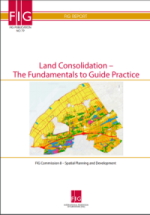FIG PUBLICATION NO. 79
Land Consolidation –
The Fundamentals to Guide Practice
FIG Commission 8 - Spatial Planning and Development
FIG REPORT
Authors:
Marije Louwsma
Walter de Vries
Morten Hartvigsen
FOREWORD
Land consolidation is a specialised land policy instrument, which has
already been on the agenda within the FIG community for a long time. Each
year there are papers submitted about land consolidation at the FIG Working
Week or Congress. Now, we decided to bundle the available international
experiences, insights, and knowledge into a FIG publication. It is my great
pleasure to present this land consolidation publication to you.
In view of climate change, sustainable land use and development is more
urgent than ever. Land consolidation is a land policy instrument that can
consider spatial developments in a coherent and comprehensive approach,
integrating various sectoral policy domains. Water management, soil quality,
environmental values, protected nature reserves, agricultural developments,
infrastructure, cultural heritage, rural development can all be considered –
at least their spatial component – in land consolidation projects.
This FIG publication aims to provide an overview of relevant topics for land
consolidation practice, including different forms of land consolidation,
public participation, valuation, developing the land consolidation plan, GIS
tools and monitoring and evaluation of projects and programmes. It seeks to
find a level of detail that provides insights for responsible agencies and
professionals involved in land consolidation.
Hopefully, this publication of commission 8 will inspire and support
government agencies, decision makers and professionals to implement land
consolidation projects and programmes in a sustainable, inclusive, and
participatory way. The expertise of the surveyor can guide the application
to enhance an inclusive, just, and fair reallocation process in various
tenure systems and land administration traditions. As such, it complements
existing publications about land consolidation such as FAO’s recent legal
guide on land consolidation.
Marije Louwsma
Chair of FIG Commission 8 – Spatial Planning and Development
2019–2022
Summary
Land consolidation is a well proven land policy instrument. Some European
countries have a land consolidation tradition that goes back hundred years
or more. As a land policy instrument, land consolidation can be used for the
implementation of government policies related to agriculture, rural
development, nature conservation and environment. The traditional objective
has been to facilitate agricultural development by reducing land
fragmentation. Nowadays, the objectives have extended to a multi-purpose
approach as well. The underpinning principle of land consolidation is the exchange of land
rights among right holders with the aim to improve effective and efficient
land use in rural areas. The exchange and redistribution of land rights can
be – and often is – combined with the construction of infrastructure, such
as the extension or enhancement of roads, the development of basic services,
the connection of ecological networks, the provision of water management or
flood protection measures, or the arrangement of climate resilience
structures in the area. In urban areas, land readjustment (on urban land
parcels or construction land) is the equivalent of land consolidation in
rural areas. Due to international variations, a common understanding of the terminology
related to land consolidation is missing. Different forms of land
consolidation (voluntary land exchange, voluntary land consolidation,
majority-based land consolidation, mandatory land consolidation) are further
explained. Depending on the objectives a simpler small-scale form of land
consolidation like voluntary land exchange can be chosen or a mandatory form
can be followed whereby multiple objectives can be realised. The latter form
is more suitable in an area with complex tasks with potentially conflicting
interests of stakeholders. Since this form of land consolidation is
mandatory it requires a legal framework that provides safeguards to secure
the land rights of involved landowners and users.
Land consolidation directly affects the area, and in particular those who
hold land rights. Therefore, it is recommended to involve the public in the
process. Public participation offers the possibility of revealing different
views, getting to know the local context, identifying potential conflicts,
and supporting decision-making. The level of public engagement depends on
the form of land consolidation, where the public’s potential influence
should be the primary consideration in designing participatory processes.
Voluntary land exchange and voluntary land consolidation provide a high
level of public participation, giving involved landowners and users a voice
in the design of the reallocation plan. If the result does not meet their
expectations, they can opt out since participation in the project is on a
voluntary basis. Public participation in majority-based land consolidation
and mandatory land consolidation has a more formalised character.
Consequently, public participation is shaped differently. The selected tools
for public participation need to meet the requirements of the land
consolidation process.
The exchange of land rights requires the valuation of the exchanged land as
to settle any differences in value between the right holders. It is one of
the key principles to guarantee a fair and inclusive process upon the
reallocation of land rights. In general, valuation in land consolidation
relies on two approaches. The relative value approach classifies parcels in
levels of value reflecting their respective productive capacity for
agriculture or other land uses. The market-based approach aims to reflect
the discrete monetary value of parcels based on the estimated market value.
This approach requires a mature land market, where sufficient land
transactions take place to provide sufficient information about current land
prices. The relative value and market-based approach are either employed
based on mass appraisal or on individual appraisal of parcels. Valuation may serve different roles based on the form of land consolidation.
Apart from the financial arrangements to be made, the valuation can also
guide individual decisions by right holders in a voluntary approach. An
involved landowner weights and assesses proposals for exchange based on the
value of the land and its financial consequences. In majority-based and
mandatory forms of land consolidation, valuation is essential to guarantee
that right holders receive an equivalent size and quality of land (the ‘at
least as well off’ principle).
The land consolidation plan includes the new layout of land parcels, related
land rights and the right holders. The development of the land consolidation
plan is usually seen as the task of a small multi-disciplinary team.
Surveyors are indispensable members of the team, since they bring in tenure
and land administration knowledge to guarantee legal certainty for all right
holders involved and expertise concerning boundary and areas measurements
and calculation. The extent to which the situation in the area changes
depends on many aspects such as the objectives of the land consolidation
project, the physical characteristics, the form of land consolidation, and
the wishes and consent of involved stakeholders. The implementation of a land consolidation project requires secure data
handling of both geospatial data (e.g. cadastral map) and administrative
data (e.g. land rights). Using GIS or other digital tools for the
implementation of land consolidation enables the automation of processes,
reduces the risk of human error – if well designed – and allows for greater
efficiency. Most countries use their own set of GIS tools for lack of a
standardised solution. Land consolidation projects and programmes require sufficient funding for
implementation. To ensure accountability and transparency, monitoring the
progress of resources used, the outputs delivered, and impact of the
activities upon implementation of a project or programme is important. A set
of relevant indicators can measure to what extent a project or programme has
been implemented according to the plan (monitoring) and achieved the desired
result (evaluation).
In view of climate change, sustainable land use and development is more
urgent than ever. Land consolidation is a land policy instrument that can
consider spatial developments in a coherent and comprehensive approach,
integrating various sectoral policy domains. The exchange of land rights
between right holders remains the underpinning principle of land
consolidation. Nevertheless, the guiding principles may change. Land may be
valued differently for example based on changing perspectives on land as a
commodity. Technical advancement of the instrument may provide one path,
whereas socio-economic equity – i.e. access to land – can lead to other
pathways. In the end, the puzzle still needs to be solved with all
stakeholders involved, balancing current and future needs for a sustainable
rural development. Marije Louwsma
Chair of FIG Commission 8, 2019–2022
Chapters
1 A general introduction to land consolidation
2 Different forms of land consolidation
3 Public participation
4 Valuation
5 Developing the land consolidation plan
6 GIS tools
7 Monitoring and evaluation of land consolidation programmes and projects
8 The way forward
Read the full FIG Publication 79 in pdf
Copyright © The International Federation of Surveyors (FIG),
September 2022.
All rights reserved.
International Federation of Surveyors (FIG)
Kalvebod Brygge 31–33
DK-1780 Copenhagen V
DENMARK
Tel. + 45 38 86 10 81
E-mail: FIG@FIG.net
www.fig.net
Published in English
Copenhagen, Denmark
ISSN 2311-8423 (pdf)
ISBN 978-87-92853-67-7 (pdf)
Published by
International Federation of Surveyors (FIG)
Layout: Lagarto
|
























